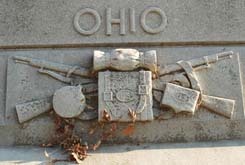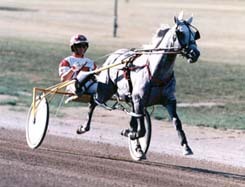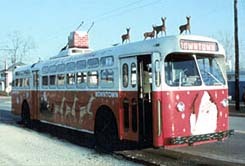
- Capital City:
- Columbus
- Nickname:
- Buckeye State
- Motto:
- With God, All Things are Possible.
- Statehood:
- March 1, 1803 (17th)
- Origin of State's Name:
- From the Iroquois Indian word for "good river."
- Largest Cities:
- Columbus, Cleveland, Cincinnati, Toledo, Akron
- Border States:
- Indiana, Kentucky, Michigan, Pennsylvania, West Virginia
- Land Area:
- 40,953 sq. mi., 35th largest
- State Bird:
- Cardinal
- State Flower:
- Scarlet Carnation (dianthus caryophyllus)
- State Tree:
- Buckeye (aesculus glabra)
- State Song:
- Beautiful Ohio
The land we call Ohio today was part the Northwest Territory that the United States won by defeating the British in the Revolutionary War. Ohio was admitted into the Union as the 17th state in 1803. The state gets its name from the river that forms its southern border. Ohio is an Iroquois word meaning "great water." The capital of the "Buckeye State" is Columbus, and, not surprisingly, the state tree is the buckeye. Highly populated, Ohio is situated between the Eastern Seaboard and the Midwest, and is known for the fact that eight presidents were either born or lived there. The flower is the scarlet carnation.
Cleveland Irish Cultural Festival

Have you ever heard of Irish step-dancing? If you have, it's probably thanks to the high-spirited Irish dance show "Riverdance." This form of Irish dance was relatively unknown outside of Ireland until the 1990s, when this show made it popular around the world.
Each summer, the traditions of Ireland are celebrated in Cleveland at the annual Cleveland Irish Cultural Festival. This celebration of the region's Irish heritage features the best in Irish entertainment from Ireland, Canada, and the United States on nine stages. The girls in this photo are doing a traditional Irish folk dance in authentic costume. Other highlights include Irish plays, pipe bands, and an Irish feis.
A feis is an Irish dance competition. There are different types of Irish dance. In addition to step dancing, there is ceili dancing. Both dances have fast footwork and kicks, all done while the upper body is kept rigidly straight. Step dancing emphasizes a close form and posture with legs kept together, no high kicks, little or no turning and no traveling. Ceili dancing emphasizes dancing on the toes, extension of leg and foot, long reach and the quick movements seen in the step dances.
Little Brown Jug Harness Race

Have you ever seen a horse race? How about a harness race? A harness race is one in which a horse pulls a light, two-wheeled vehicle called a sulky. Harness racing developed from the old days when horses and buggies raced each other on country roads or city streets.
Basically, there are two major types of horse racing -- riding a horse with a saddle and harness racing. There are two types of horses that compete in harness racing: one is the pacing horse, which moves both legs on one side of its body at the same time, and the other is the trotting horse, whose left front and right rear leg move forward at the same time, then right front and left rear leg move together. Because there are two types of horses, there are two kinds of harness racing: trotting or pacing.
If you want to see a horse pacing race go to Delaware, Ohio, for the Little Brown Jug Harness Race, which takes place every year on the third Thursday after Labor Day. The Little Brown Jug is a race for three-year-old pacing horses. The first race was held in 1946. Back then, trotting horses were more popular, but two men in the city liked pacing horses, so they formed the Little Brown Jug Society and organized the race.
Dayton, Ohio, Electronic Trolley Bus (ETB) System

Why are there reindeer on top of that trolley car?
That's the Christmas Trolley in Dayton, Ohio, one of only a few cities in the United States that still operates an electric trolley bus system for its mass transportation.
The trolley, invented in Germany in the early 1880s, was called the "trackless trolley," "trolley coach," "trolley bus" and eventually the "electric trolley bus." Trolley buses are propelled (moved forward) by electric motors and receive power from an overhead wire system. They are full-size buses that run on rubber tires and are steered just like other buses. They operate almost silently and produce no smoke or pollution.
In 1888, the White Line Electric Railway began running a route in downtown Dayton and, by 1910, five separate companies had built other lines. The trolley remained the primary mode of city transportation until the early 1930s. After a fire in 1932, the Dayton Street Rail Road Company replaced its destroyed trolley cars with electronic trolley buses (ETBs). These ETBs, which began running on April 23, 1933, continued the trolley legacy in Dayton.
Ohio State Fair

From the very first fair of three days in 1850 in Cincinnati to the 17-day exposition today, the Ohio State Fair has celebrated Ohio's products, its people and their accomplishments.
Although at first primarily an agricultural fair, in 1853, entertainment crept into the Fair with the first pony rides for children and monkeys dressed up in hats that danced to minstrel tunes. Today's entertainment appeals to modern tastes, and the Ohio State Fair has hosted stars from Ricky Nelson in 1957 to Johnny Carson in 1968 to New Kids on the Block in 1989 to Willie Nelson in 1998. Vince Gill, Johnny Cash, the Oak Ridge Boys, the Osmonds, Bob Hope, Barbara Mandrell, and Dolly Parton have been repeat performers.
Each year, the sale boasts some of the highest bids of any state fair in the nation. In 1996, the Sale of Champions made Ohio State Fair history with bids totaling $212,000 for eight livestock exhibits. The Youth Reserve Program was established in December 1995 to reward junior youth exhibitors that participate at the Ohio State Fair. The program allots funds for scholarships, Future Farmers of America (FFA), 4-H and other Fair competition winners.
One unique aspect of the Fair is the Butter Sculpture. In the early 1900s, the Ohio State University and the dairy processors of Ohio sponsored butter sculpting contests at the Fair. Each year a butter cow, and later a butter calf, are sculpted and have become a Fair tradition. Each sculpture takes approximately four weeks to complete, and approximately 1,500 pounds of real butter is used to make the sculpture. Another unique aspect of the Fair is the focus on llamas: A Llama Drill Team, a Llama Costume Contest and llama obstacle course (the "Leaping Llama" contest) for kids and their animals delight Fair spectators.
 Print
Print Email
Email







